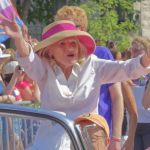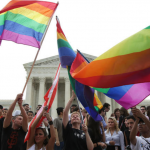- Joe Negrelli, 68, was a participant of the Stonewall uprising that occured in the early hours of June 28, 1969.
- Negrelli, who was 17 at the time, recalled how it was routine for the police to raid bars that served liquor to LGBTQ+ people. The police would arrest them for touching, kissing, or dancing — all actions that were considered disorderly conduct.
- The Stonewall veteran told Business Insider there is a tremendous lack of knowledge when it comes to how bad LGBTQ+ people were treated throughout America’s history.
- He is happy with the progress the movement has made, but feels there’s still a long way to go.
- Visit Business Insider’s homepage for more stories.
Fifty one years ago, on a steamy June 28th evening, New York policemen showed up at the Stonewall Inn for what was then considered a routine raid of gay bars.
Joe Negrelli, a 68-year-old New Yorker, remembers that night well. He was 17 at the time.
“It was indescribably hot,” he told Business Insider. “You see, apartments back then, they were walk-ups and they didn’t have air conditioning. So when it got hot and humid, it got unbearable.”
Because of the weather, there were more people at the bar than usual. That meant more potential arrests, Negrelli explained.
The Stonewall Inn was one of only a handful of bars in Manhattan that served drinks to LGBTQ+ clientele. Back then, you could be thrown out of a bar if there was even suspicion that you might be gay, lesbian, transgender, or otherwise queer.
This wasn’t the first encounter with police for many of the Stonewall patrons that evening.
“If two men or two women were holding hands in public, the nicest thing a police officer would do was demand they stop. Most of the time, they threw slurs at you and beat you with their baton,” Negrelli said.
Raids were regular, especially at the Stonewall Inn. Police would claim the bar was operating without a proper liquor license. They would arrest LGBTQ+ people for touching, kissing, or dancing, actions considered disorderly conduct.
And at those raids, LGBTQ+ people weren’t just arrested, however. They were often also photographed by members of the media, who would then publish their full names and photos in their newspapers. As a result, those arrested would often get evicted from their homes or fired from their jobs. There were little civil rights protections, explained Negrelli, who is a member of the SAGE USA, an advocacy group for LGBTQ+ elders.
Public outings caused by these arrests had serious consequences. State officials, and even parents of minors, could mandate forced lobotomies of gay men, a brutal “conversion therapy” practice.
So when the police showed up that evening at the Stonewall Inn, the patrons decided to resist.
“People were really pissed off. They were really irked to the point where they decided to stand up for the first time in their life,” he said.
As the group grew angrier, someone threw a glass bottle in the direction of the police. According to Negrelli, an officer demanded that whoever threw the bottle come forth and submit to arrest.
After a few seconds of silence, another glass bottle was thrown in the direction of the police. Then a garbage can was flung in the officer’s direction. Soon, police tried to barricade themselves inside the bar, at which point a bottle containing cigarette lighter fluid, which most smokers carried with them, was set on fire and thrown into the bar.
A small fire broke out, Negrelli said, and chaos ensued. Backup riot police were called in, and many were arrested.
A year later, hundreds of people gathered again outside the Stonewall Inn to commemorate the anniversary of the uprising. That march, from Greenwich Village to Central Park, would become what’s widely know as the first Pride parade.
“If you had told me decades ago that the gay liberation movement would get to this point, where we’d go from being arrested, evicted, fired from our jobs for being gay to now the Supreme Court ruling we can’t be discriminated against at work, I wouldn’t believe you! I can’t believe it’s happened during my lifetime,” he said.
Negrelli added, however, that the movement still has a long way to go, citing discrimination and anti-gay and anti-transgender violence across the country.
According to the most recent FBI data, there were 7,120 hate crime incidents reported in 2018. More than 1,300 of those — nearly 19% — were committed against LGBTQ+ people. In 2019, advocates tracked at least 27 deaths of transgender or gender nonconforming people in the US due to fatal violence, the majority of whom were Black transgender women, per the Human Rights Campaign. And GLAAD and The Harris Poll’s 2019 Acceptance Index showed a decline in LGBTQ+ acceptance among younger Americans.
There are many Americans who don’t know how much intolerance there was and still is today, Negrelli said.
“There’s a tremendous lack of understanding of how far the LGBTQ+ movement has come,” he said.
This year, Pride parades across the country, including New York City’s, have been canceled due to the coronavirus. But that doesn’t mean people aren’t marking the important day; many are tuning into online events, like the virtual Global Pride on June 27.
This article originally appeared in Business Insider on June 27, 2020.







